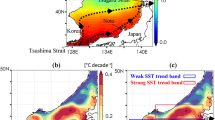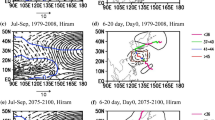Abstract
In order to understand the properties of the winter circulation in the northern China Sea, a two-dimensional numerical model has been established and calculated for an ideal sea basin.
In the model we employed a quadratic conservative scheme for a complete set of dynamic and thermodynamic equations. The systematic analysis of stability produced a series of mathematically and physically restrictive conditions which are more general than those derived by Irvine, and Chen.
Using this model we made calculations on a series of interesting phenomena, such as the Yellow Sea Warm Current, two gyres in the Yellow Sea, etc. as well as their developing processes. The simulation can also explain the generation mechanism of the phenomena.
Similar content being viewed by others
References
Chen Changsheng and Qing Zhenghao, 1985. A model of numerical analog of typhoon storm surge along the Zhejiang coast.J. of Shandong College of Oceanology 15(1): 9–18. (in Chinese with English abstract)
Cheng Jinsong, 1966. Distribution theory and algebraic solution of multi-term equation root.Appl. Math. and Comp. Math. 3(4): 225–236. (in Chinese)
Choi Byung Ho, 1982. Note on currents driven by a steady uniform wind stress on the Yellow Sea and the East China Sea.La Mer. 20(2): 65–74.
Feng Shizuo, et al, 1981. A model of circulation in East China Sea. II. Similarity criterion of summer circulation.Journal of Shandong College of Oceanology 11(2): 8–26. (in Chinese with English abstract)
Feng Shizuo, et al, 1986. On tide-induced Lagrangian residual current and residual transport. 2. Residual transport with application in South San Francisco Bay, California.Water Resources Research 22(12): 1635–1646.
Heaps, N. S., 1978. Linearized vertically-integrated equation for residual circulation in coast seas.Deutsch Hydrographische Zeitschrift, Z. 31, H.S., 147–169.
Hsueh Y. et al, 1986. Wintertime winds and coastal sea-level fluctuations in the Northeast China Sea. Part II: Numerical Model.J. Phys. Oceanogr. 16: 241–261.
Talley, L. D., 1984. Meridional heat transport in the Pacific Ocean.J. Phys. Oceanogr. 14(2): 231–241.
Xi Pangen, et al, 1980. A model of circulation in East China Sea. I. Numerical simulation of winter circulation.Journal of Shandong College of Oceanology 10(3): 13–25. (in Chinese with English abstract)
Yuan Yaochu, et al, 1982. A single-layer circulation model of continental shelf of the East China Sea.Acta Oceanologica Sinica 4(1): 1–11. (in Chinese with English abstract)
Yuan Yaochu, et al, 1983. A two-layer circulation model of the East China Sea. Proceedings of International Symposium on Sedimentation on the Continental Shelf, with Special Reference to the East China Sea. Vol.1, 364–374.
Author information
Authors and Affiliations
Additional information
Contribution No. 1523 from Institute of Oceanology, Academia Sinica
Rights and permissions
About this article
Cite this article
Jia, W., Yeli, Y. Numerical modelling of wintertime circulation in the East China sea. Chin. J. Ocean. Limnol. 6, 300–319 (1988). https://doi.org/10.1007/BF02850454
Received:
Issue Date:
DOI: https://doi.org/10.1007/BF02850454




